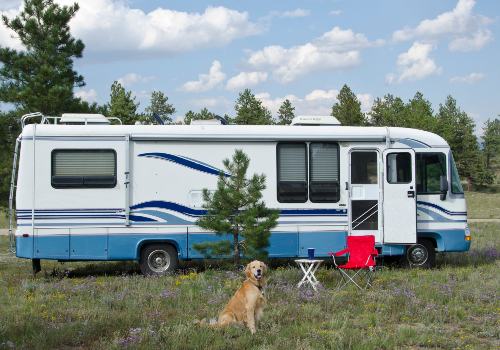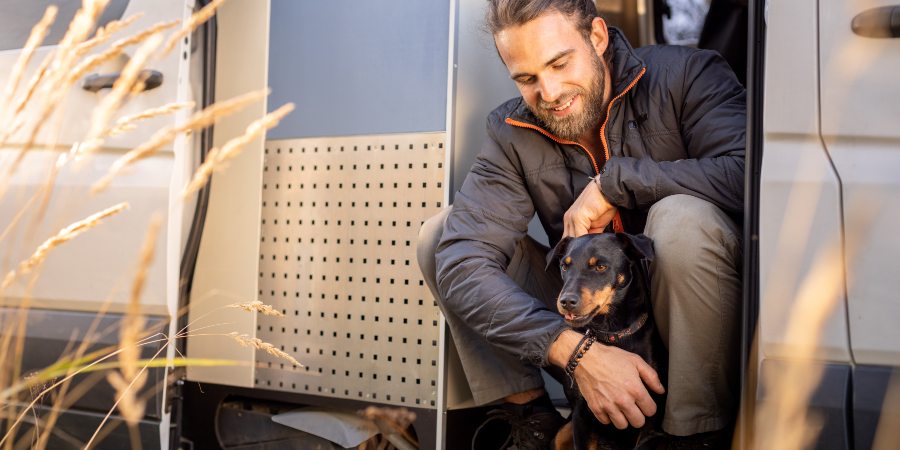Thinking about hitting the road in your RV with your four-legged friends? Whether you’re a dog lover or a cat enthusiast, bringing your pet on your RV adventure can make the experience even more enriching. But how do you ensure the journey is enjoyable and safe for both you and your beloved pets?
We’ve got you covered with essential tips for traveling in an RV with cats and dogs. From ensuring their comfort to keeping them safe, let’s explore how to make your RV trip a smooth ride for everyone involved.
RV Pets
In the U.S., approximately 40 percent of all households have at least one dog, and about a third of households have one or more cats. America’s love of pets has grown to include a wide variety of furry, feathered, and scaled pets.
Visit any campground in the morning, and you’ll see how many dogs travel as your RV neighbors take the first-morning walk. Inside the RV lurk indoor cats and a wide variety of other contained pets.
Pet Travel Laws

The U.S. is relatively lax in-laws regarding traveling with pets. Livestock, such as horses and cows, are required to be in approved trailers, but travel with dogs and cats isn’t as regulated in the U.S. as in Europe.
RELATED ARTICLE: Best Farm Animals for RV Life
Health regulations are a little more stringent but rarely enforced. Children traveling in vehicles are required by state and federal laws to be safely secured in approved equipment, but most states don’t regulate travel with dogs, cats, and other pets.
Pet Travel Safety
Want to Connect With a Community of Over 1,078 RV Enthusiasts?
Common sense, however, requires that pets be safely and comfortably constrained or confined in any moving vehicle. If some crazy driver decides to cut in or stop in front of your travel rig, you don’t want a 10-to-100+ pound living object flying through the air inside your vehicle. That goes for both motorized and towing RVs.
The type of constraint depends on the type and size of the pet. Restrain smaller (up to about 20 pounds) four-legged pets in a harness. Don’t depend on just a leash attached to a collar.
Above 20 pounds, consider a soft- or hard-sided carrier. The final decision depends on what the pet is most comfortable in. If you have crate-trained your pet, use a crate carrier. If the pet prefers visibility, try a harness.
First time out, gently load your pet in the appropriate constraint (with treat bribes) and take it for a short ride to condition the pet and test the setup.
Pet Travel Tips

20 Suggestions for Safe and Secure RV Pet Travel
- If traveling out of state or on a long trip, make sure you have the pet’s health records with you.
- Before traveling to Canada or Mexico, make sure your pet has appropriate rabies and other shots along with documentation.
- If your pet appears sick to border inspection station personnel, they may require a health certificate from your veterinarian before entry.
- As appropriate, have your vet insert an identification microchip in your pet and register it with a pet chip registry.
- If pet tags have your telephone number, make sure it is for the phone you take with you on trips.
- Take an ample supply of your pet’s preferred food and treats so you don’t have to change its diet on the road.
- Train your pet to return to you with a special call or the shaking of a dry food container.
- Never allow your pet to sit on the driver’s lap, restrained or otherwise.
- Never leave a pet in a trailer being towed or alone in a vehicle in the heat.
- Consider pet harnesses that clip into passenger seat belts.
- In walking pets, obey state, local, and park leash laws. Most limit leases to 6 feet.
- Make sure a pet carrier is securely fastened with a seat belt or harness to the floor.
- Travel can be traumatic for some pets. Ask your vet about tranquilizers and other travel aids.
- Take familiar objects for your pet, including bedding, toys, and special treats, to make the trip more enjoyable for all.
- Be cautious of using public dog parks and rest area pet lawns as they may harbor pet diseases.
- Once at your location, make sure your pet has sufficient cool water to drink.
- If your pet is litter-trained, take a litter box with you on your RV trip.
- If your pet isn’t a good traveler, check into boarding or pet/house sitter before you plan your trip.
- Look for books, websites, and other resources for pet-friendly campgrounds, destinations, and events.
- Always keep in mind the safety and enjoyment of your traveling pet(s) as well as other passengers.
Tips for Traveling with Pets in an RV (Video)
"Man cannot discover new oceans unless he has the courage to lose sight of the shore."
-- Andre Gide











